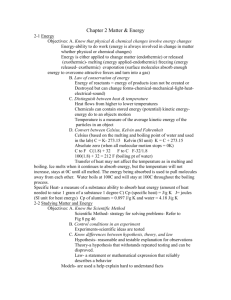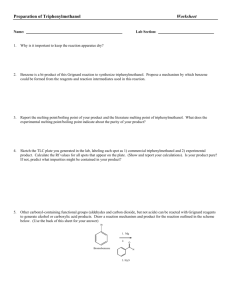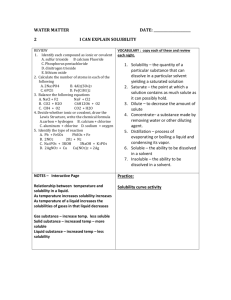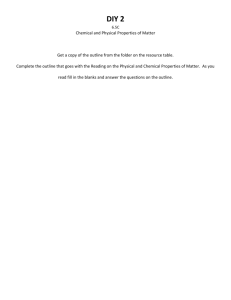Physical Properties Lab: Identifying Substances
advertisement
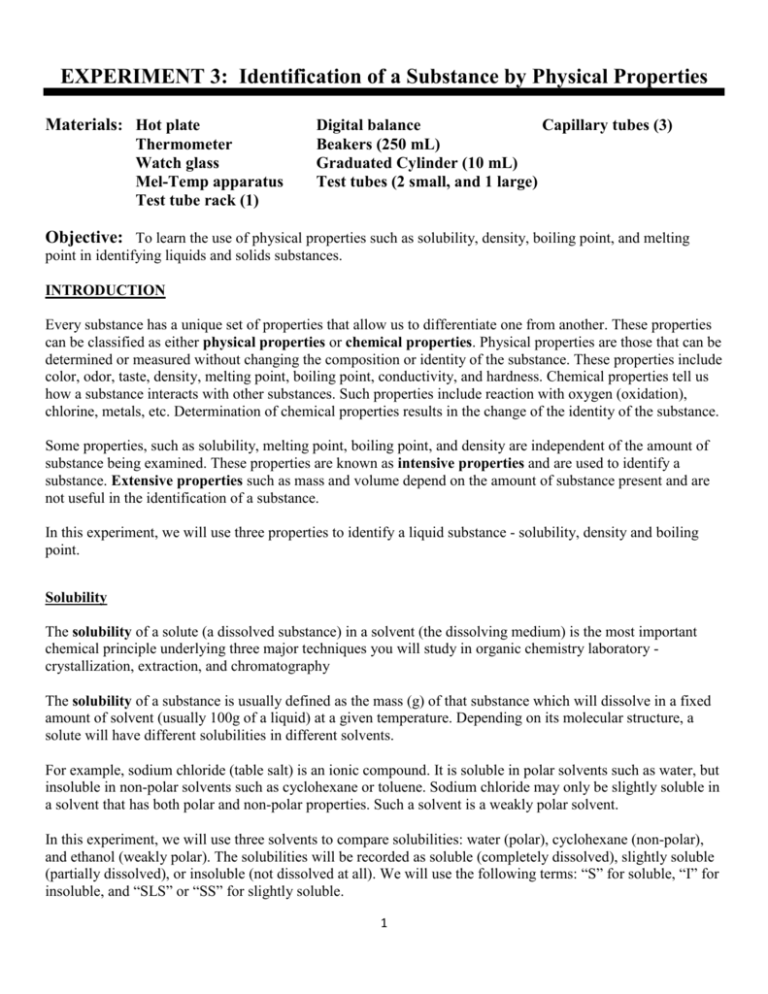
EXPERIMENT 3: Identification of a Substance by Physical Properties Materials: Hot plate Thermometer Watch glass Mel-Temp apparatus Test tube rack (1) Digital balance Capillary tubes (3) Beakers (250 mL) Graduated Cylinder (10 mL) Test tubes (2 small, and 1 large) Objective: To learn the use of physical properties such as solubility, density, boiling point, and melting point in identifying liquids and solids substances. INTRODUCTION Every substance has a unique set of properties that allow us to differentiate one from another. These properties can be classified as either physical properties or chemical properties. Physical properties are those that can be determined or measured without changing the composition or identity of the substance. These properties include color, odor, taste, density, melting point, boiling point, conductivity, and hardness. Chemical properties tell us how a substance interacts with other substances. Such properties include reaction with oxygen (oxidation), chlorine, metals, etc. Determination of chemical properties results in the change of the identity of the substance. Some properties, such as solubility, melting point, boiling point, and density are independent of the amount of substance being examined. These properties are known as intensive properties and are used to identify a substance. Extensive properties such as mass and volume depend on the amount of substance present and are not useful in the identification of a substance. In this experiment, we will use three properties to identify a liquid substance - solubility, density and boiling point. Solubility The solubility of a solute (a dissolved substance) in a solvent (the dissolving medium) is the most important chemical principle underlying three major techniques you will study in organic chemistry laboratory crystallization, extraction, and chromatography The solubility of a substance is usually defined as the mass (g) of that substance which will dissolve in a fixed amount of solvent (usually 100g of a liquid) at a given temperature. Depending on its molecular structure, a solute will have different solubilities in different solvents. For example, sodium chloride (table salt) is an ionic compound. It is soluble in polar solvents such as water, but insoluble in non-polar solvents such as cyclohexane or toluene. Sodium chloride may only be slightly soluble in a solvent that has both polar and non-polar properties. Such a solvent is a weakly polar solvent. In this experiment, we will use three solvents to compare solubilities: water (polar), cyclohexane (non-polar), and ethanol (weakly polar). The solubilities will be recorded as soluble (completely dissolved), slightly soluble (partially dissolved), or insoluble (not dissolved at all). We will use the following terms: “S” for soluble, “I” for insoluble, and “SLS” or “SS” for slightly soluble. 1 Part of this experiment will involve determining whether an organic solid compound is soluble or insoluble in a given solvent. You should keep in mind that this is actually an over simplification since some solids may be partially soluble in a given solvent. If an organic liquid compound dissolves in a solvent, it is sometimes more appropriate to say that the compound and the solvent are miscible (mix homogeneously in all proportions). Likewise, if an organic liquid compound is insoluble in the solvent, then they are immiscible (do not mix and forms two liquid phases). The concentration of a solution can be derived by expressing solubility in quantitative terms. An example is the solubility of table salt in water which is 35.9 g/100 cc of water. Density Density = mass / volume or D = m / v Density is defined as mass per unit volume. Mass is usually measured in g and volume in mL or cm3. Since two substances rarely have the same density, it is a useful physical property in order to identify unknown substances. “Heavy” elements such as lead and gold have high densities while elements that are “light in weight” typically have low densities. For most substances, the variation in density with temperature is negligible. It is usually expressed at 20°C, which is considered to be room temperature. The density of water from 0° to 30°C, is tabulated in Table 1. The density of a liquid is usually reported in units of grams per milliliter (g/mL). The density of a solid is reported in units of grams per cubic centimeter (g/cm3). Because 1 mL is equivalent to 1 cm3, these units are interchangeable. The density of water is 1.00000 g/cm3 at 4°C and is slightly less at room temperature (0.9970 g/cm3 at 25°C). Boiling point Boiling point is defined as the temperature at which the vapor pressure of a liquid becomes equal to the pressure at the surface of the liquid. The boiling point of a liquid can change if the pressure at the surface of the changes. Since pure substances have a distinct boiling points, boiling points are sometimes used to determine the purity of substances. A liquid gets converted in to its gaseous state when the temperature of the liquid reaches its boiling point. This is indicated by bubbles of its vapor rising in all parts of the liquid. This is the temperature at which the pressure of the saturated vapor of the liquid is equal to the pressure of the atmosphere under which the liquid boils. Normally, boiling points are determined at standard pressure: 760 mm Hg (torr) or 1 atm. The boiling point of a liquid is sensitive to changes in atmospheric pressure and varies directly with it. At approximately normal pressure, the boiling point of a liquid will drop about 0.5 C° for every 10-mm Hg drop in pressure. At much lower pressures, close to 10 mmHg, the temperature will drop about 10 C° when the pressure is halved. 2 Melting point The melting point of a solid is defined as the temperature at which the liquid and solid phases are in equilibrium at a given pressure. At this temperature, a solid is converted to liquid. This is an important property of solids. The melting point of solids, like the boiling point of liquids, is often used for the identification of substances. The normal melting point of a solid is defined as the temperature at which the solid and liquid phases of a solid are in equilibrium at a total pressure of 1atm. Pure crystalline substances have clear, sharply defined melting points. During the melting process, all of the energy added to a substance is consumed as heat of fusion, and the temperature remains constant. A pure substance melts at a precisely defined temperature, characteristic of every crystalline substance and dependent only on pressure. In contrast to the volume change that accompanies the vaporization of a liquid, the change in volume that takes place upon the melting of a solid is very small. This makes the melting point of a solid, unlike the boiling point of a liquid, practically independent of any ordinary pressure change. The melting point of a solid can be easily and accurately determined with small amounts of material, making this physical property the most used for the identification and characterization of solids. SAFETY PRECAUTIONS The unknown liquids used in this experiment are flammable. Although the danger of fire is greatly reduced by the use of small samples, it is not eliminated. Keep all liquid samples away from open flames. Avoid inhaling vapors from volatile liquids. The vapors from the liquids used in this experiment may be irritating and can be toxic if you are exposed to them for long periods of time. These problems are minimized by using small amounts of the liquids. If you are bothered by the odors of any liquids, work in the fume hood. Avoid skin contact with the volatile liquids. 3 EXPERIMENTAL PROCEDURE I. LIQUID - Identification of a liquid substance utilizing the physical properties of solubility, (miscibility), density and boiling point. PART A. Solubility 1. Take two test tubes and set them in a rack. Add 2 ml of water to the first test tube and 2 ml of ethanol to the second test tube. Add 2 ml of your unknown to each test tube, shake well, and observe whether the two liquids mix completely, partially or not at all. 2. If the two liquids mix completely, it will appear as if only one liquid is present. The two liquids are soluble (miscible) in each other. 3. If the two liquids do not mix at all, indicated by a visible line of separation after shaking and allowing to stand for about a minute. The liquids are insoluble (immiscible). 4. The unknown liquid may be „partially soluble‟, as judged by the amount remaining separate after shaking as compared to the amount initially added. Record the solubility of your unknown as “s” for soluble, “i” for insoluble, or “sls” for slightly soluble. PART B. Density 1. 2. 3. 4. 5. Place a 10 ml graduated cylinder on the balance and tare. Transfer about 5 ml of your unknown liquid to the 10 ml graduated cylinder. Record the mass and record the exact volume. Calculate the density of the liquid and record. Save the liquid. PART C. Boiling point 1. To determine the boiling point of your unknown liquid, pour about 5 ml (retained from your density determination above) into a large test tube. (See Fig. 1). 2. Add a boiling chip to the liquid. 3. Start a water bath by filling a 250 ml beaker with tap water and place on a hot plate. 4. Using a ring stand and clamp to support the test tube containing the unknown liquid, place a thermometer into the liquid. Make sure that the bulb of the thermometer is submerged into the liquid. Submerge the test tube in the boiling water bath. 5. Heat the unknown liquid until it begins to boil, monitoring the thermometer readings. Record the temperature at which the liquid boils. This will be the point where the liquid is boiling but the temperature reading is stable. Do not allow the liquid to boil to dryness. Fig. 1 4 II. SOLID - Identification of a solid utilizing the physical properties of solubility in water, solubility in ethanol, density, and melting point. PART A. Solubility 1. Take two test tubes and set them in a rack. Add 2 ml of water to the first test tube and 2 ml of ethanol to the second test tube. 2. Add a FEW crystals of your unknown solid to each of the test tubes. Shake briefly. 3. Observe whether the crystals dissolve completely, dissolve to some extent, or do not dissolve. 4. Record on your data sheet “s” for soluble, “sls” for slightly soluble, or “i” for insoluble. PART B. Density 1. Fill your 10 ml graduated cylinder to the 5 ml mark with the liquid in which your unknown was not soluble in Part A. 2. Read the volume to the nearest 0.05 ml. Record this initial volume on your data sheet. 3. Place the 10 ml graduated cylinder + liquid on the balance and tare the balance (re-set to zero). 4. While the graduated cylinder is on the balance, add a few crystals of your unknown to the liquid in the graduated cylinder until the balance reads about 0.5g. Record the mass of your crystals on the data sheet. 5. Making sure that the crystals are completely submerged, read the final volume of the liquid in the cylinder. Record this final volume on your data sheet. 6. To find the volume of your solid, subtract the initial volume of the liquid from the final volume of the liquid. 7. Calculate the density of your solid and record. D = m/v 8. Pour most of the liquid into the sink and dispose of the solid part of the sample in the solid waste container provided by your instructor. PART C. Melting point 1. Obtain 3 capillary tubes. 2. Place some of your unknown on a watch glass and push some unknown into the open end of the capillary tube until you have about ¼ inch of unknown in the tube. Tap the crystals down to the closed end until they are well packed. 3. Using the Mel-Temp apparatus, set the plateau temperature to 100⁰C. Place 2 capillary tubes into the apparatus and press start. (See Fig 2 or Fig. 3 using hot water bath). View your samples through the viewfinder. Record on the data sheet the temperature at the instant the first crystal begins to melt. This is your melting point. To verify the melting point temperature, you may wish to repeat the procedure with your last test tube, 4. Discard the capillary tubes in the “Glass Disposal” containers. Fig. 2 Fig. 3 5 Guidelines for using a single-pan balance: 1. Do not place chemicals directly on the pan. Instead, use a weighing paper, a beaker, a watch glass, or weighing bottle. 2. Do not weigh hot or warm objects. Objects must be at room temperature. 3. Return all weight to the zero position after weighing. 4. Clean up any chemical spills in the balance area. 5. Inform your instructor if the balance is not operating correctly. Do not attempt to repair it yourself. Reference Table Density (g/ml) Melting Point ⁰C Boiling Point ⁰C Acetone 0.79 -95 Heptane 0.58 Isopropyl Alcohol Substance Solubility Water Ethanol 56 s s -91 98 i sls 0.79 -86 83 s s Methanol 0.79 -98 65 s s Naphthalene 1.15 80 218 i sls Potassium Alum 1.76 92 n/a s i Benzil 1.5 95 347 i s Benzophenone 1.09 49 306 i s Acetamide 1.16 81 222 s s 1-Propanol 0.8 -127 97 s s Cyclohexane 0.78 6.5 81.4 i s Benzoic Acid 1.07 1.22 249 i s 6 EXPERIMENT 3: Identification of a Substance by Physical Properties REPORT SHEET Name: ___________________________ Date: ___________________________ Instructor: ___________________________ LIQUID PART A. Solubility Liquid: Unknown Number __________ Solubility: Water __________ Ethanol __________ Weight of the Liquid __________ g Volume of the Liquid Density of the Liquid __________ g/ml PART B. Density __________ml Calculation: PART C. Boiling Point Boiling Point _________ oC (range) 7 Unknown Liquid Identity ____________ SOLID PART A. Solubility Solid: Unknown Number __________ Solubility: Water __________ Ethanol __________ PART B. Density Mass of the solid __________ g Initial Volume of the Liquid __________ ml Volume of the Solid Unknown __________ ml Density of the Solid Unknown __________ g/ml Final Volume of the Liquid __________ml Calculation: PART C. Melting Point Melting Point : ____________ o C (range) 8 Unknown Solid Identity ____________ EXPERIMENT 3: Identification of a Substance by Physical Properties Name: ____________________________ Pre-Laboratory Questions and Exercises Due before lab begins. Answer in the space provided. 1. In the Handbook of Chemistry and Physics (CRC), use the Table of Physical Constants of Inorganic Compounds to look up the melting point, boiling point and color for the following compounds: Compound Melting Point Boiling Point Color Page Lead Iodide Lead Chromate Silver Bromide 2. Define the following terms and give two examples of each: Extensive Property: Intensive Property: 3. How is solubility expressed? What is the solubility of table salt in water? 5. Besides the physical properties used to identify a substance in this experiment, what other physical properties might be used to characteristically identify a substance? 9 EXPERIMENT 3: Identification of a Substance by Physical Properties Name: ____________________________ Post-Laboratory Questions and Exercises Due after completing the lab. Answer in the space provided. 1. How is the solubility of sugar in water affected by increasing the temperature? 2. Why does an oil and vinegar salad dressing have two separate layers? 3. Classify the following properties of sodium metal as physical or chemical: 4. a. Silver metallic color _______________ b. Turns gray in air _______________ c. Melts at 98oC _______________ d. Reacts explosively with chlorine _______________ A student's liquid unknown boils at approximately 65°C and is soluble in water and ethanol. Its measured density is 0.80 g/ml. Which substance in Table 1.1 is the student's unknown 10

